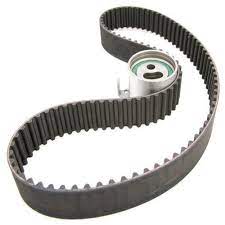Description :
A used timing belt is a critical component in many internal combustion engines, serving the important function of synchronizing the rotation of the engine's crankshaft and camshaft. This synchronization is crucial for the proper operation of the engine, ensuring that the intake and exhaust valves open and close at the correct times in relation to the position of the pistons.
Here are key aspects of a used timing belt:
1. *Material:* Timing belts are typically made from a durable rubber compound reinforced with nylon or other high-strength materials. The rubber provides flexibility, while the reinforcement enhances strength and resistance to stretching.
2. *Teeth:* Timing belts have teeth on one side that mesh with gears on the crankshaft and camshaft. The teeth ensure a positive engagement, preventing slippage and maintaining precise timing.
3. *Tensioner:* To maintain proper tension in the timing belt and prevent slack, engines often include a tensioner. This component helps to keep the belt in place and ensures that it remains properly aligned with the gears.
4. *Idler Pulleys:* In addition to the tensioner, idler pulleys may also be used to guide the timing belt and maintain its proper alignment. These pulleys contribute to the stability and longevity of the belt.
5. *Maintenance:* Timing belts have a finite lifespan and are subject to wear over time. Manufacturers typically recommend specific intervals for timing belt replacement, and it is crucial to adhere to these recommendations. Failure to replace a worn or damaged timing belt can result in severe engine damage due to the misalignment of critical components.
6. *Interference Engines:* In some engines, the design is such that the pistons and valves occupy the same space but at different times. If the timing belt were to fail in such an "interference engine," there's a risk of the pistons colliding with the valves, causing significant and expensive damage.
7. *Replacement:* Replacing a timing belt is a complex and often labor-intensive task. It involves removing various engine components to access the belt. The replacement process also provides an opportunity to inspect and potentially replace other related components, such as the water pump, which may be driven by the timing belt.
Regular maintenance, including timely replacement of the used timing belt, is crucial to ensure the continued smooth and efficient operation of the engine while preventing costly damage. It's important to follow the manufacturer's recommendations regarding timing belt replacement intervals and to address any signs of wear or damage promptly.


